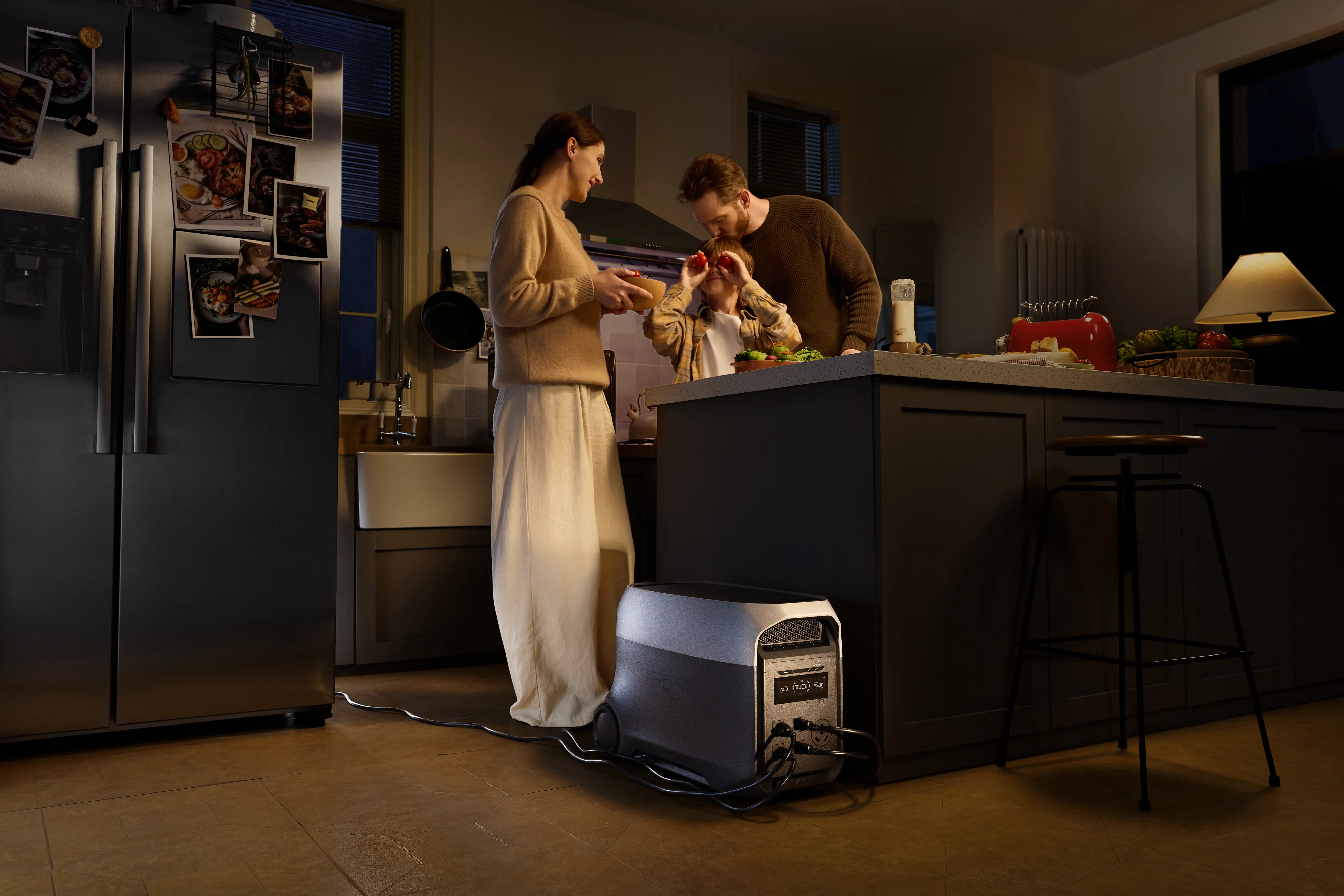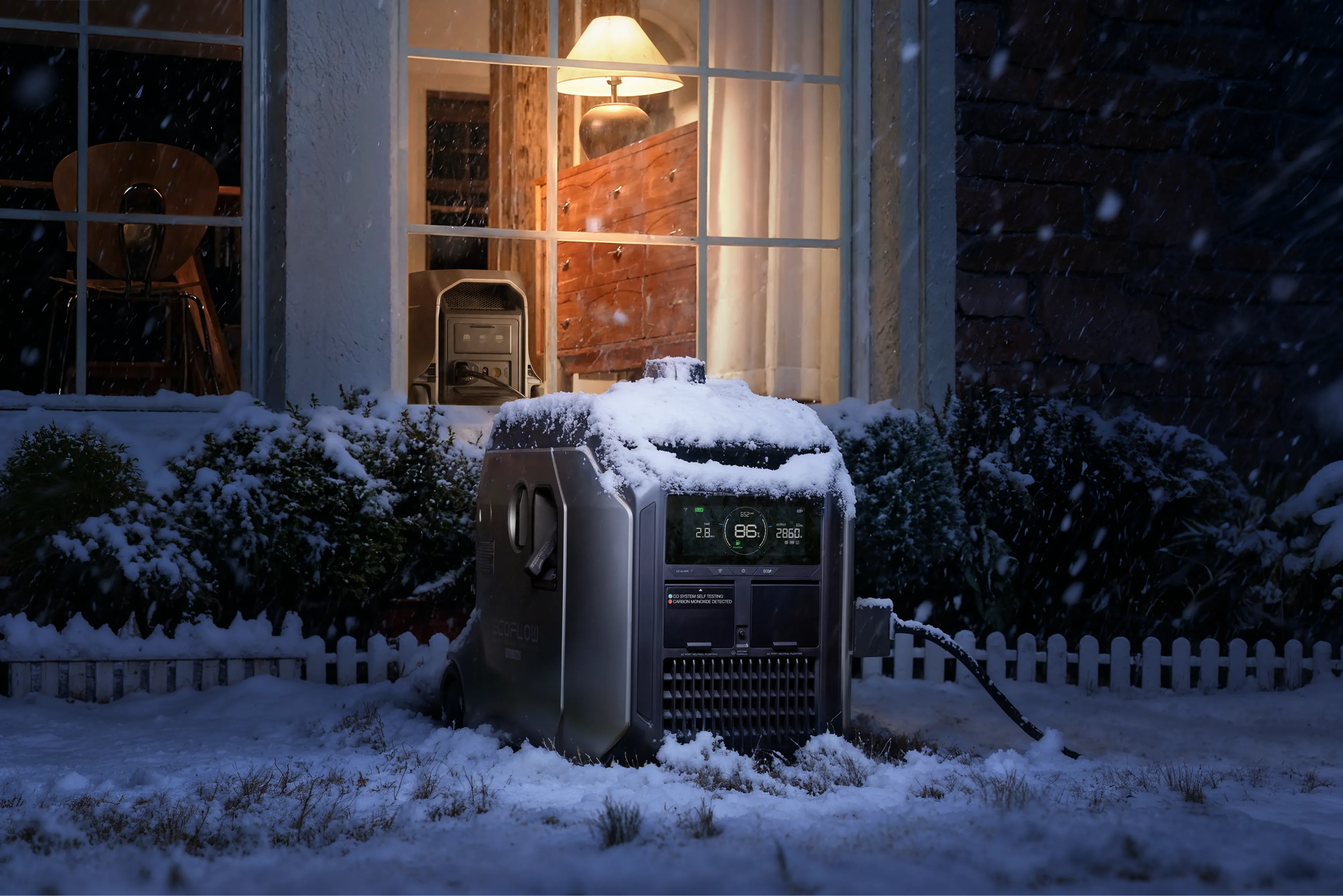How to Prepare for a Cold Wave
The crisp, refreshing air of a Canadian autumn often signals cozy evenings and the slow build into winter. But sometimes, what begins as a typical frosty day can spiral into something much more dangerous: a cold wave. Defined by a sudden and severe plunge in temperature, these events can freeze entire cities, strain public infrastructure, and put health and safety at risk.
While Canadians are no strangers to snow and sub-zero conditions, a cold wave pushes even the most winter-ready households to their limits. Whether you live in Toronto, Calgary, or Vancouver, the impact of extreme cold can be felt everywhere, from frozen pipes and power outages to hazardous travel conditions.
This guide is designed to help you prepare with confidence. We’ll break down the science behind cold waves, outline the key risks they bring, and share practical steps to safeguard your home, your family, and your daily routines. From emergency kits to reliable power backup solutions, you’ll find everything you need to stay safe and resilient when the temperature takes its sharpest plunge.
What Causes a Cold Wave
Understanding the causes of a cold wave is the first step in preparing for one. These extreme events aren’t random, they stem from specific atmospheric shifts that allow frigid Arctic air to push deep into Canada. When the jet stream or polar systems weaken, twist, or collapse, they create pathways for cold air to surge south, plunging regions into a sudden deep freeze.
Polar Cold Air Movement
One of the main drivers of a cold wave is the southward push of Arctic air. Under normal conditions, this frigid air mass is locked near the poles by the jet stream, which acts like a barrier. But when the jet stream weakens or bends out of its usual pattern, it creates openings for cold air to spill south, much like a dam giving way. Once this happens, huge pools of polar air sweep into lower latitudes, bringing sudden, severe drops in temperature. In cities like Montreal, this direct influx of Arctic air explains why cold waves can be especially harsh and long-lasting, turning a routine winter chill into dangerously cold conditions.
Westerly Circulation Disturbances
The jet stream, a powerful ribbon of wind high above the Earth, typically flows smoothly from west to east and helps regulate our weather. When this circulation becomes disturbed, however, the jet stream no longer follows a straight, stable path. Instead, it develops dramatic waves that dip far south into North America and curve northward over the Atlantic. These dips, or troughs, act as open corridors for Arctic air to surge downward. When one of these patterns sets up over Canada, it can trigger a sudden and severe plunge in temperatures, turning what might have been a manageable winter day into the deep freeze conditions we associate with a cold wave.
Polar Vortex Instability
The “polar vortex” is a term many Canadians hear each winter, and it plays a central role in the development of cold waves. This system is a massive area of low pressure and bitterly cold air that usually swirls tightly around the Arctic. When stable, it contains the cold air near the pole. But if the jet stream weakens or shifts, the vortex can wobble, stretch, or even split apart, sending chunks of frigid air southward into mid-latitude regions. When this instability occurs, Canada often experiences its most severe cold waves, with temperatures plummeting far below seasonal norms. What would normally be a typical winter day can quickly turn into a bone-chilling deep freeze that strains homes, infrastructure, and health systems alike.
Extratropical Cyclone Impact
Although cyclones are usually linked to tropical storms, extratropical cyclones, large weather systems that form outside the tropics, can also set the stage for a cold wave. These systems often develop along strong temperature contrasts and can pull Arctic air southward into their circulation. As the cyclone moves across a region, it drags this cold air mass behind it, creating a sharp boundary where temperatures can plunge dramatically within hours. In Canada, this is why a seemingly mild winter day can turn bitterly cold almost overnight. The powerful winds that follow the cyclone’s passage not only drive the frigid air in but also amplify the chill, making the onset of a cold wave feel sudden and severe.


The Risks of Extreme Cold Temperatures
The dangers of a cold wave extend well beyond simple discomfort. When temperatures plummet, the effects ripple through every layer of society, putting lives at risk, straining infrastructure, and disrupting the rhythm of daily life. Recognizing these threats is the first step toward preparing for them effectively.
Endangering Public Health and Vulnerable Groups
Extreme cold poses an immediate threat to human health. Prolonged exposure can trigger hypothermia, where the body’s temperature drops to dangerously low levels, or frostbite, which damages skin and deeper tissues. These risks are heightened for vulnerable groups such as seniors, young children, and individuals experiencing homelessness, who may lack adequate shelter or protection. During a cold wave, communities must pay special attention to these groups, ensuring that emergency shelters, warm clothing, and medical support are readily available.
Damaging Infrastructure and Electrical Grid
Cold waves can push a city’s infrastructure to its breaking point. Frozen pipes often burst, flooding homes and businesses with costly damage. At the same time, the electrical grid faces enormous pressure as households turn up the heat, sometimes driving demand beyond capacity. The result can be widespread power outages, cutting off heat, light, and cooking facilities just when they’re needed most. In cities like Calgary, a blackout during sub-zero temperatures isn’t just inconvenient, it’s a serious emergency that underscores the need for a reliable home battery backup solution.
Disrupting Transportation, Energy and Production
A severe cold wave can bring daily life to a grinding halt. Transportation systems, from city buses to cross-country railways, often face major slowdowns. Roads become treacherous with black ice, while airports may shut down as runways freeze. The energy sector also struggles, with reduced output from power plants and challenges in distributing fuel to where it’s needed most. These disruptions ripple into production and manufacturing, forcing closures and breaking supply chains. For a country as vast and interconnected as Canada, even a short-lived cold wave can cause widespread economic setbacks, underscoring the importance of planning ahead.
How to Protect Your Home Against Severe Cold Weather
Your home is your sanctuary during a cold wave, and preparing it properly is the best way to stay safe and avoid costly damage. A few preventative steps can make all the difference when temperatures plunge.
Insulating Windows and Doors
A large portion of home heat is lost through poorly sealed windows and doors. Before a cold wave sets in, carefully inspect all exterior openings. Apply weather stripping around doors and use window insulation film to reduce drafts. Draft stoppers at the base of doors add another inexpensive layer of protection. These simple steps help keep warm air in and icy air out, making your home more comfortable and energy efficient.
Keeping Your Water Pipes from Freezing
Frozen or burst pipes are one of the most costly problems during a cold wave. To avoid this, insulate any exposed pipes in unheated areas such as basements, crawl spaces, and garages. When temperatures plunge, let a small, steady drip of water run from your faucets, since moving water is less likely to freeze. It’s also essential to know the location of your main water shutoff valve so you can act quickly if a pipe bursts.


Preparing Your Home Heating System
Your furnace or heating system is the backbone of your home’s defense against extreme cold. Schedule an inspection and servicing with a professional before winter arrives to make sure it’s running efficiently and safely. Replacing your furnace filter regularly will also improve performance and reduce strain on the system.
For added security especially in Canada, where cold waves can be severe and power outages are a real possibility, consider a portable power solution. A device like the EcoFlow Delta 3 Ultra (3072Wh) provides more than just backup; it offers a reliable way to keep essential appliances like space heaters, refrigerators, and communication devices operating during an outage. With its high capacity and ability to handle demanding loads, it ensures your family stays warm, safe, and connected even in the harshest conditions.
Stocking Up on Essential Supplies
Preparation for a cold wave starts with ensuring your household has enough supplies to get through at least three days without outside support. Stock up on non-perishable food items, bottled water, and any prescription medications your family relies on. Emergency essentials like flashlights, extra batteries, a well-stocked first-aid kit, and plenty of warm blankets should also be ready and easy to access. If you have pets, remember to include food, water, and other necessities for them too. A small investment in advance can make a big difference when temperatures drop and conditions outside are unsafe.
Ensuring Whole-Home Backup Power Resilience
During a severe cold wave, a full power outage is a real possibility, and being prepared can make all the difference. For true whole-home backup, the EcoFlow DELTA Pro Ultra X offers unmatched reliability. Unlike small portable generators or low-capacity units, it delivers high power output and long-lasting battery life, making it capable of running your furnace, refrigerator, lights, and Wi-Fi at the same time. For households in rural or remote parts of Canada, where outages can last for days, this system provides not only warmth and safety but also peace of mind. By investing in a solution built to withstand extreme conditions, you ensure your family stays connected and secure no matter how low the mercury drops.
How to Stay Safe Outdoors in Cold Waves
While it’s always safest to remain indoors during a cold wave, there are times when going outside is unavoidable. In these cases, taking the right precautions is essential to protect yourself against the extreme cold.
Plan Your Route and Share Your Itinerary
Before heading out, check both the weather forecast and road conditions. If travel is necessary, stick to well-traveled routes and highways, where help is more readily available. Always let a friend or family member know your destination and estimated arrival time. If your vehicle breaks down or you encounter an emergency, this information could be life-saving.
Master the Layered Dressing Principle
Dressing in layers is the most effective way to stay warm. Start with a moisture-wicking base layer (avoid cotton, which traps dampness), add an insulating mid-layer like fleece or wool, and finish with a windproof, waterproof outer layer. Remember to protect extremities with a hat, insulated gloves, and warm, waterproof boots, as most body heat is lost through the head, hands, and feet.
Recognize and Respond to Hypothermia and Frostbite
Knowing the warning signs of cold-related illnesses is vital. Hypothermia symptoms include intense shivering, confusion, slurred speech, and loss of coordination. Move the person indoors, remove any wet clothing, and wrap them in blankets. Frostbite, marked by numbness, tingling, or waxy skin, should never be treated by rubbing; instead, gently rewarm the area with body heat or lukewarm water and seek medical attention immediately.
Guard Against Black Ice and Snow Blindness
Black ice poses one of the greatest risks during cold waves, forming as a thin, nearly invisible sheet on roads, bridges, and sidewalks, making both walking and driving treacherous. Always move with caution, reduce speed when driving, and wear shoes with good traction when walking. Another danger is snow blindness, which is a painful, temporary eye condition caused by the sun’s UV rays reflecting off snow and ice. Protect yourself by wearing UV-blocking sunglasses or ski goggles to keep your vision safe.
Prepare the Best Camping Gear for Cold Weather
Winter camping in the Canadian wilderness demands proper preparation and reliable gear. A sturdy four-season tent, a sleeping bag rated for extreme cold (such as -20°C or below), and a high R-value sleeping pad are essential to stay warm and insulated against frozen ground. Pack extra stove fuel, along with more food and water than you expect to need, since conditions can change quickly. To stay connected and keep critical gear like headlamps or communication devices powered, a portable power station such as the EcoFlow Delta 3 Ultra is a valuable addition, ensuring both safety and convenience in remote environments.


Conclusion
A cold wave is not just a sharp drop in temperature, it’s a true test of resilience and preparation. By understanding the atmospheric forces behind these events, securing your home, and practicing safe habits outdoors, you can greatly reduce the risks they bring. Stocking essentials, reinforcing heating systems, and having reliable backup power solutions like the EcoFlow DELTA Pro Ultra X or EcoFlow Delta 3 Ultra ensures your household remains safe, warm, and connected even during extended outages. With foresight and the right tools, Canadians can face even the harshest winter conditions with confidence.
FAQ
What is the difference between a cold wave and normal winter weather?
A cold wave differs from normal winter weather in both intensity and speed. While regular winter conditions bring cold temperatures that arrive more gradually and can usually be managed with routine preparation, a cold wave is defined by a sudden, sharp plunge in temperature that reaches dangerously low levels within a short time. This rapid change places far greater stress on people, infrastructure, and services, creating risks such as frostbite, hypothermia, frozen pipes, and power grid failures, dangers not typically associated with normal winter cold.
How should I prepare my car for extremely cold weather?
To prepare your car for extremely cold weather, start by checking your antifreeze levels and making sure the mixture is balanced to prevent freezing. Use winter-grade windshield washer fluid that won’t freeze in sub-zero temperatures, and confirm your battery is fully charged and in good condition, since batteries lose power in the cold. Inspect your tires for proper tread and consider switching to winter tires for better grip. Always keep an emergency kit in your trunk with essentials like a warm blanket, a small shovel, a flashlight with extra batteries, jumper cables, and a bag of sand or kitty litter to help with traction if you get stuck. It’s also wise to keep extra snacks, bottled water, and a phone charger in case you’re stranded for an extended period.
Is it safe to use a portable heater indoors?
Yes, it can be safe to use a portable heater indoors, but only if proper precautions are followed. Always place the heater on a flat, stable, non-flammable surface and keep it well away from curtains, bedding, furniture, or anything that could catch fire. Choose models with built-in safety features such as tip-over protection and automatic shut-off if overheating occurs. Never use extension cords with portable heaters, and avoid leaving them running unattended or while you sleep. For added safety, ensure your home has working smoke detectors and, if you’re using a fuel-burning heater, a carbon monoxide detector as well.
What should I do if the power goes out?
If the power goes out during a cold wave, the first step is to stay calm and safe. Unplug or turn off non-essential appliances to avoid damage from a surge when electricity is restored. To prepare for a winter power outage, ensure you have reliable backup power solutions, such as the EcoFlow Delta 3 Ultra, to keep essentials like a heater, fridge, or phone charged and running. Dress in layers, close off unused rooms, and block drafts to conserve heat. Check in on neighbours, especially seniors or vulnerable individuals and if your home becomes too cold, head to a designated warming centre or safe shelter in your community.
How can I help vulnerable neighbours during cold temperatures?
Helping vulnerable neighbours during extreme cold can make a big difference. Start by checking in regularly to ensure they have heat, food, and necessary medications. Offer assistance with errands, like grocery shopping or picking up prescriptions, and help clear snow or ice from their walkways to reduce fall risks. Even a simple friendly visit or phone call can provide reassurance. If they’re struggling, encourage them to use local warming centres or community support services to stay safe.